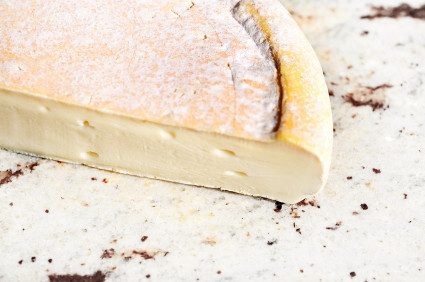Here in San Francisco, we require functioning furnaces throughout the summer months, when fog and gusty winds surround the hills of the city and make for some cool weeks. While our temperatures certainly aren’t freezing, they do mean that despite the abundance of tomatoes, sweet corn, wax beans, and fresh stone fruit of all kinds, one’s tastes can still turn to something heartier. Because tartiflette has been on my list of things to make for nearly a year, it seemed a good opportunity to give it a go.
Although tartiflette has origins as far back as the 18th century, it gained wider prominence in the 1980s, when the makers of reblochon cheese began to highlight the recipe as a way of promoting their soft-rined, raw-milk, slightly stinky cheese. The name reblochon is derived from the verb “reblocher” (to pinch a cow’s udder again*), which refers to the tax-evasive practice of French farmers returning to cows for a second milking, the results of which are a richer milk.
To make an authentic tartiflette, reblochon is de rigeur, though hard to accomplish, given the U.S. ban on imported raw-milk cheeses. Le Delice du Jura, a similar cheese from the same region, is more widely available at any gourmet grocery. However, a combination of brie and gruyere is also a reasonable substitute (a concept unknown, perhaps, to the French) and—because I am not a fan of brie—I went all out and stuck exclusively with gruyere. Many would argue that my recipe can hardly be called a tartiflette because of this substitution, and they are probably correct. So let’s just call it “tartiflette inspired.”
Tartiflette
2 1/2 pounds waxy potatoes, like Yukon Gold
1 Tbsp. butter + more for greasing the pan
Salt and pepper to taste
2 sweet onions, on the larger side
6-8 slices of bacon (not too smoky)
3/4 c. dry (and not too fruity) white wine
1/2–3/4 c. heavy cream
8 oz. gruyere, coarsely grated (or 1/2 grated gruyere & 1/2 sliced brie, if that’s more to your tastes)
Preheat the oven to 425 degrees. Butter a 3-qt casserole dish. Roughly peel the potatoes and slice into disks somewhere between a 1/4″ and 1/2″ thick. Put in a large pot, cover with cold salted water, and cook until just tender. Drain and set aside. While the potatoes are cooking, cut each onion in half, pole to pole, and then into slivers, again from pole to pole. Cut the bacon into 1/4″-wide lardons. Combine the butter, bacon, and onions in a wide skillet and cook over medium heat until the onions have softened and the bacon is browning, about 15 minutes, stirring regularly. Add the wine to the skillet and reduce until nearly all the liquid is evaporated. Add the cream, beginning with the lesser amount. The mixture should be creamy but not runny. Season with salt and pepper to taste.
Put half the potatoes in the buttered dish, top with half of the onion mixture, and then a few small handfuls of cheese. Repeat the layers, finishing with the remaining cheese. Bake about 25 minutes, until the top is brown and bubbling. Let it sit a few minutes before serving, then eat with a simple arugula salad and plenty of cold beer.
Here is what the dish—prepared with an entire reblochon, as its makers intended—looks like.
*Really, who but the French would have such a word?



Recent Comments